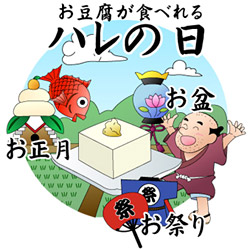

Although tofu was well established in Japanese daily cuisine by the mid-Edo period of Japan, in the early Edo period, tofu was reserved for special occasions. For farmers, tofu was a luxury food that could not be eaten on just any day.
gFinest Days (Hare-no-Hi)h

Tofu cuisine was reserved for special days and festivals such as the Obon Festival, New Yearfs Day, and other ceremonial occasions in the farming villages of Japan. Such days were called the gFinest Days (Hare-no-Hi)h of which the Japanese tradition of wearing special clothing was inherent to further represent such special gComing of Ageh occasions. As with todayfs gFestive red riceh of Japan, tofu was eaten only on ceremonious occasions.
In contrast to these gFinest Days (Hare-no-Hi)h, normal days were called gEvery Days (Ke-no-Hi)h. The everyday cuisine of this time was limited to miso soup, pickles, Kinzanji miso (mixed vegetable miso), etc. This frugal diet was the norm for farmers in the early Edo period.
Aside from tofu, the dinner table on the gFinest Days (Hare-no-Hi)h was adorned with other luxuries such as deep-fried tofu, konjak (devilfs tongue), ganmodoki (deep fried tofu with mixed vegetable mince), shiitake mushrooms, burdock root, etc. Furthermore, these gFinest Daysh were the only occasions when farmers could eat rice and drink sake.
At the time of Tokugawa Ieyasu and his son Hidetada, the production of udon, soba noodles, and tofu was prohibited in rural villages. At one point an official ban was placed entirely forbidding the consumption of these foods by farmers.
The gKeian Proclamationh issued at the time of the third shogun Iemitsu defined tofu as a luxury item and clearly forbids its production by farmers. Records also show that the typical food menu for the shogun included tofu soup, delicate tofu, fried tofu for breakfast and gmockh tofu (tofu broken down and re-set with other ingredients added) for lunch.
Tofu finally became everyday food for the common folk in the mid Edo period. At this time tofu was still limited to the tables of common folk in big cities such as Edo, Kyoto and Osaka, however.



